Westside Toastmasters is located in West Los Angeles and Santa Monica, California
Chapter 6
I'VE GOT TO HAND IT TO YOU
Scientific research shows that more nerve connections exist between the hands and the brain than between any other part of the body, and so the gestures and positions we take with our hands give powerful insights into our emotional state. Our hands are usually positioned in front of our body, consequently these signals are easy to pick up and most of us have several trademark hand positions we continually use. Unconsciously, your hands reveal your attitude towards another person, place, or situation.
Watch how your hands move spontaneously in greetings, farewells, and as you come to mutual agreement with someone else. Before you know it, your hands illustrate a point you're making and are effective in demonstrating both your sincerity as well as your annoyance. Whether you're expressing love, anger, joy, or frustration, your hands hold the message.
In this section we will discuss how you can use your hands to support the spoken word and add substance to your message. You find out how to position your hands to convey authority and dominance as well as demonstrate openness and submission. You see how other people reinforce what they mean by the way they mimic the actions or situations they're describing. You will discover the telltale signals that the hands and fingers unconsciously reveal when you think no one is watching.
How the Hands Talk
For thousands of years, the level of status people held in a society would determine the priority order in which they could hold the floor when speaking. The more power or authority you had, the more others would be compelled to stay silent while you spoke. For example, Roman history shows that a low-status person could be executed for interrupting Julius Caesar.
Today, most people live in societies where freedom of speech in the abstract teems reasonably well, if for no other reason than the proliferation of mobile phones and social media. Usually anyone who wants to put forward an opinion can do so. In many countries, the hands have taken on the role of 'punctuation marks' to regulate turn-taking in physical conversation. A raised hands gesture has been borrowed from the Italians and French, who are the biggest users of 'hand talking'.
In Italy, the order of talking is simple - the person with his hands raised has the floor and does the talking. The listener will have his hands down or behind his back. So the trick is to try to get your hands in the air if you want to get a word in and this can be done either by looking away and then raising them or by touching the other person's arm to suppress their hand as you raise yours. Many people assume that when Italians talk they are being friendly or intimate because they continually touch each other, but in fact each is attempting to restrict the other's hands and take the floor.
Watching how a person summarizes a discussion giving both points of view can reveal whether they have a bias one way or another. They usually hold one hand palm up and articulate each point and then give the opposing points on the other hand. Right-handed people reserve their favored point of view for their right hand and left-handers favor their left.
Boosting Positive Reaction
Using hand gestures grabs attention, increases the impact of communication and helps individuals retain more of the information they are hearing. An analysis of TED Talks found that the most popular, viral speakers used an average of around 500 hand gestures, which is nearly twice as many as the least popular speakers used. Other research has found that people who "talk" with their hands tend to be viewed as warm, agreeable and energetic, while those who are less animated are seen as logical, cold and analytical.
Evaluating the retention of information in memory, researchers Geoffrey Beattie and Nina McLoughlin at the University of Manchester conducted a study where volunteers listened to stories featuring cartoon characters. For some listeners, a narrator added hand gestures such as moving the hands up and down quickly to show running, a waving movement to demonstrate a hair dryer and arms wide apart to show a fat opera singer. When the listeners were tested ten minutes later, those who had seen the hand gestures had up to a third higher response when recalling the details of the stories, demonstrating the material effect hand gestures have on our recall ability.
We will evaluate some of the most common hand and thumb gestures in widespread use.
Rubbing the Palms Together
Out at a restaurant for dinner one night with a friend we discussed summer vacation plans. As the vision of the plans expanded and became more of a reality this friend broadly smiled, rubbed her palms together rapidly and exclaimed, 'I can barely wait!' That body language told us non-verbally that she expected the trip to be a high point of her year.
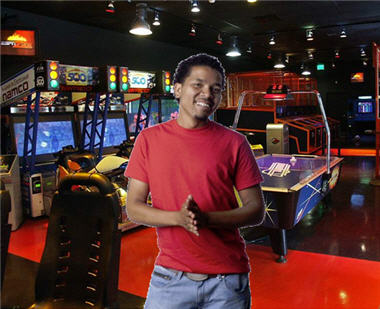
Showing positive expectations
Rubbing the palms together is a way in which people communicate positive expectation. The dice thrower rubs the dice between his palms as a sign of his positive expectancy of winning, the master of ceremonies rubs his palms together and says to his audience, 'We have been looking forward to hearing our next speaker,' and the excited salesperson struts into the sales manager's office, rubs his palms together and says excitedly, 'We've just nailed down the Johnson contract!' The waiter coming to your table at the end of the evening rubbing his palms together and asking, 'Anything else, sir?' is non-verbally telling you that he expects a good tip.
The speed at which a person rubs their palms together signals who he thinks will receive the positive benefits. Say, for example, you want to buy a home and you visit an estate agent. After describing the property you want, the agent rubs his palms together quickly and says, 'I've got just the right house for you!' In this way the agent has signalled that he expects the results to be to your benefit. How would you feel if he rubbed his palms together very slowly as he told you that he had the ideal property? He'd seem sneaky or devious and you'd get the feeling that he expected the results to benefit him, not you.
Salespeople are taught to use the palm rub gesture when describing products or services to prospective buyers, and to use rapid hand action to avoid putting buyers on the defensive. When a customer quickly rubs his palms together and says, 'Let's see what you have to offer!' it signals that he's expecting to see something good and might buy.

'Have I got a deal for you!'
Always remember context: a person who rubs his palms together briskly while standing at a train station on a cold winter day may not necessarily be doing it because he's expecting the train momentarily. More likely he does it because his hands are cold.
Rubbing Fingers Together
Rubbing the thumb against the index finger or fingertips is commonly used as a money expectancy gesture. Its symbolism is that of rubbing a coin between the thumb and fingertips. It is often used by the street vendor who says, 'I can save you 40%,' or by the person who says to his friend, 'Can you lend me a hundred bucks?'

'We can make money out of this!'
This gesture should be avoided at all times by any professional person who deals with clients because it carries negative associations about money.
Hands Clenched Together
Think back to a time when you were really scared, nervous, or holding back a strong negative emotion. Chances are that you were clenching your hands for all you were worth and your knuckles were a bright white: the stronger the emotion, the tighter the clench. In addition to the strength of the clench you can also take meaning from where the clenched hands are placed.
Studies indicate that the higher the hands are held in the clenched position the stronger the negative mood. So, if your boss is sitting with her elbows resting on her desk and her hands are clenched in front of her face, she's probably going to be difficult to handle. By putting her hands near her mouth she's indicating that she's holding back what she would like to say. Be careful not to push her too far. She just may unclench those hands and let the words fly ... which may not please you.
At first, this gesture can seem to signal confidence as some people who use it often also smile. Research into the clenched hands position by negotiation experts Nierenberg and Calero showed that it was also a frustration gesture when used during a negotiation, signalling that the person was holding back a negative or anxious attitude. It was a position assumed by a person who felt they were either not convincing the other person or thought they were losing the negotiation.

Hands clenched in raised position may reveal frustration, even when smiling
The hands clenched gesture has three main positions: hands clenched in front of the face; hands clenched resting on the desk or on the lap; and, when standing, hands clenched in front of his genitals.

Former Argentina President Cristina Kirchner with hands clenched in center position
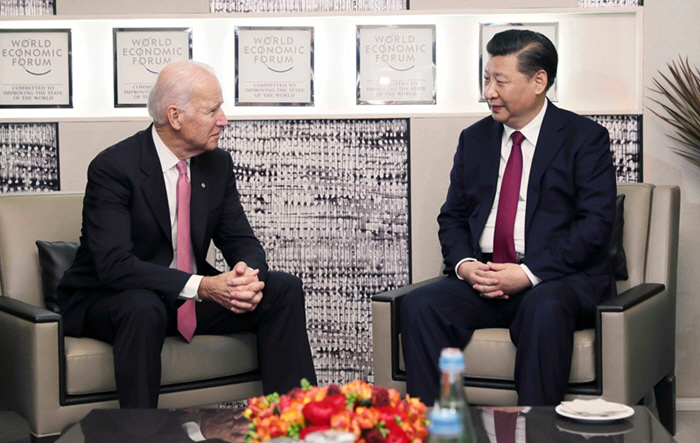
Joe Biden and President Xi Jinping of China, both with hands clasped. Frustration demonstrated?
Steepled Hands
In his studies of body movements, Ray Birdwhistell noted that people viewing themselves as reputable and among the elite had minimalist gestures and tended to use a restricted 'steepled' finger position to demonstrate their confident attitude. You can achieve this position by letting your finger tips lightly touch like the steeple on a building. This gesture is also called the 'power position' because it's often used in a superior/subordinate interaction and usually indicates a confident or self-assured attitude. Lawyers, accountants, and anyone in a position of authority frequently give instructions or advice with their fingers in this position. People who consider themselves more elevated in formal or informal power often use this gesture and, by doing so, signal their confident attitude.
So far, we've emphasized that gestures come in clusters, like words in a sentence, and that they must be interpreted in the context in which you observe them. Steepling can be an exception to these rules, as it often occurs in isolation. The fingers of one hand lightly press against those of the other hand to form a church steeple and will sometimes oscillate back and forth like a spider doing push-ups on a mirror.
Steepled fingertips have two main versions, the raised steeple, the position often assumed when giving his / her opinions or ideas or is doing the talking; and the lowered steeple, which is normally used when the person is listening rather than speaking.
The raised steeple: When the fingers are raised in front of the chest, the speaker is giving thoughts or opinions. Use the raised steeple position judiciously. Taken to extremes it can convey an arrogant 'know-it-all' attitude. If you tilt your head backwards when taking this position don't be surprised if you're perceived as smug or arrogant.
Those who use this gesture sometimes convert steepled hands unconsciously into a praying gesture in an attempt to appear more God-like. As a general rule, raised steepled hands should be avoided when you want to be persuasive or win the other person's confidence.
The lowered steeple: When you're listening you may find your fingers in the lowered steeple position. You look interested and ready to respond when you put your hands together like this. Women tend to use this position more often than the raised steeple.
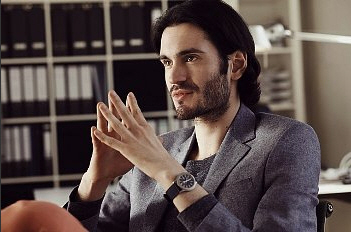
Confident he has the right answers

Emmanuel Macron may be attempting to appear more exalted
If you want to look as if you are confident and have all the right answers, the steepled hands position will do it for you.
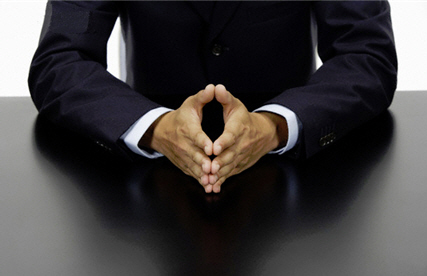
The lowered steeple indicates a listening attitude.
Although the steeple gesture is a positive signal, it can be used in either positive or negative circumstances and may be misinterpreted. Let's say you are presenting an idea to someone and have seen them using several positive gestures during the presentation, such as open palms, leaning forward, head up, nodding and so on. Let's say that towards the end of your presentation the other person begins to steeple their hands.
If steepled fingers follows a series of other positive gestures and appears when you show the other person the solution to his problem, it's more likely you've been given the go-ahead. On the other hand, if the steepled hands gesture follows a series of negative gestures such as arm folding, leg crossing, looking away and hand-to-face gestures, he may be confident that he won't say 'yes' or that he can get rid of you. In both these cases steepled fingers registers confidence, but one has positive results and the other negative consequences. The gestures preceding steepled fingers are the key to the outcome.
Summary
Your hands are always in front of you, revealing your emotions and attitudes. Many body language gestures can be difficult to learn but hand gestures can be practiced and rehearsed to a point where you can have fairly good control over where your hands are and what they are doing. When you learn to read hand gestures you'll look more confident and feel more successful.
Framing The Face
This is not a negative gesture - it's a positive one used in courtship. It's used mainly by women and by gay men who want to attract a man's attention. A woman will place one hand on top of the other and present her face to a man as if it was on a platter for him to admire.

Presenting her face for a man to admire
If you are going to use flattery - sincere or not - this gesture gives the green light for it.
Gripping Hands, Wrists, And Arms
If you want to project superiority and confidence put your hands behind your back and grip one hand with the other. Look at prominent male members of royal families around the world. Observe senior military personnel, police officers patrolling their beats, or the headmaster of your local school striding through the corridors. They all adopt this position of authority. They are showing no fear of exposing their vulnerable necks, hearts, or stomachs to potential threats and hazards.
The next time you're in a stressful or uncomfortable situation, adopt the palm-in-palm-behind-the-back stance. Note how your feelings change from frustrated, insecure, or angry to relaxed and confident.
As the grip moves up the arm, though, the meaning changes. You can bet that if someone is gripping her wrist behind her back rather than just her hand she's holding back frustration. This gesture is a way of maintaining self-control, as if the hand is holding the wrist or arm to keep it from hitting out. The farther up the back the hand goes the greater the level of frustration. By the time the hand reaches the upper arm this person may have moved from frustration to anger. This gesture is also a sign of nervousness and is an attempt at self-control.
Holding Hands Behind the Back
This gesture is common among leaders and royalty and is used by the policemen patrolling the beat, the headmaster walking around the school playground, senior military personnel and anyone in a position of authority.
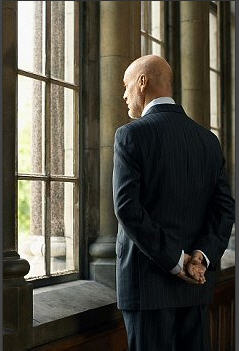


Back and front views of the superiority-confidence gesture
The emotions attached to this gesture are superiority, confidence and power. The person exposes their vulnerable stomach, heart, pelvis, and throat in a subconscious act of fearlessness. Our experience shows that, if you take this position when you are in a high-stress situation, such as being interviewed by TV reporters or waiting outside a dentist's surgery, you will begin to feel confident and even authoritative, as a result of cause and effect.
Research with law enforcement officers showed that officers who do not wear firearms use this position regularly and often rock back and forth on the balls of the feet when standing to gain additional height. Police officers who wear firearms seldom use this gesture, preferring to let their arms hang by their side or to have their thumbs tucked into the belt. The firearm gives the officer sufficient power that Palm-in-Palm behind the back is not a necessary display of authority.
The Hand-Gripping-Wrist gesture communicates a different emotion to Palm-in-Palm behind the back. It is a signal of frustration and an attempt at self-control. One hand grips the other wrist or arm tightly behind the back, as if in an attempt by one arm to prevent the other from striking out.
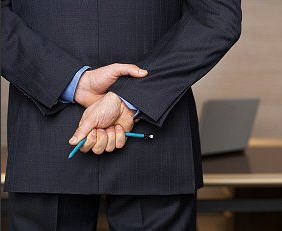
The Hand Gripping Wrist gesture
The higher up one hand grips the opposite arm, the more frustrated or angry the person is likely to be. In the first image below we see moderate self-control while in the second, the gentleman is showing a progressively greater attempt at self-control than in the previous picture, because the hand is gripping the upper arm, not just the lower arm or wrist. This gesture shows the origin of the expression, 'Get a grip on yourself.'
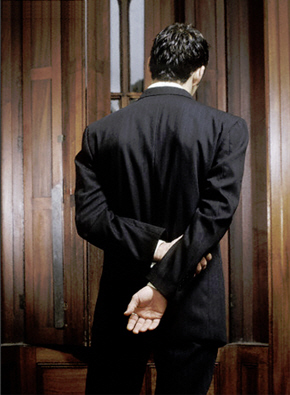

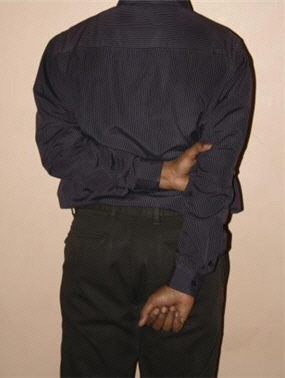
The Lower Arm Grip and the Upper Arm Grip
Wrist and arm gripping behind the back can often be observed outside a courtroom when warring parties are face to face, in salespeople standing in a customer's reception area and in patients waiting for a doctor. It's an attempt to disguise nervousness or self-restraint and, if you catch yourself doing it, change to the Palm-in-Palm behind the back and you will begin to feel more confident and in control.
Gesturing With Your Thumbs
Why, among all the primates were Homo Sapiens able to make extra-ordinary progress? A major contributing factor to human progress is the presence of an opposable thumb i.e. a thumb placed opposite to the fingers thus enabling it to stretch away from the hand. Most primates (chimpanzees, gorillas, monkeys) and some other animals also have opposable thumbs but they can't move their thumb as far away from the hand as humans. The thumb is also physically the most powerful finger in the human hand.
Due to this superior opposability of the thumb, human beings were able to make tools, weapons, and complicated structures. It also enabled us to write; hence language was born. Language led to mathematics, science, and literature and the complexity of culture we know today.
Gestures associated with the thumb convey dominance, superiority, and in some cases aggression so it's not surprising that in palmistry the thumb denotes strength of character and ego. If you've ever heard the expression 'under the thumb' you know the implication is that the person with the thumb is the one in control. Woe betide the person under the thumb, as according to ancient Roman history the thumb turned down served as a sign of imminent death.Thumbs up: The thumb up position generally denotes agreement. But be careful using this gesture as in some cultures it's perceived as rude and highly offensive.
Thumbs protruding from a person's pockets: This gesture demonstrates dominance and self-assuredness. Although both men and women use this gesture, it's the rare woman who adopts the position of holding her jacket lapel with the thumb exposed, whereas men often do. Gesturing towards another person with your thumb: When you use your thumb to point towards someone else, you're being dismissive, disrespectful, or ridiculing the other person.
Andrew had the unfortunate habit of ridiculing Jane, his wife, in front of their friends. When they were in company he would often refer to her as 'the little woman' gesturing in her direction with a closed fist, using his thumb as a pointer. Although Jane told him how irritating she found this gesture, as well as the accompanying remarks, Andrew took no notice. He did notice, however, when after several years of rude and disrespectful behaviour Jane divorced him.
Thumb Displays
As mentioned earlier, se of thumbs denotes superiority. In palmistry, the thumbs represent strength of character and the ego, and body language signals involving the thumbs also show self-important attitudes. Thumbs are used to display dominance, assertiveness or sometimes aggressive attitudes; thumb gestures are secondary gestures and are usually part of a cluster. Thumb displays are positive signals, often used in the typical pose of the 'cool' individual who uses them to show superiority. A man will use Protruding Thumbs around women to whom he is attracted and people who wear high-status or prestige clothing also display their thumbs. You will rarely see a low-status individual, such as a vagrant, doing it.
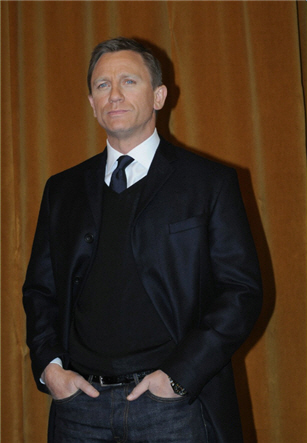
Protruding Thumbs - Daniel Craig
Thumb displayers also often rock on the balls of their feet to give the impression of extra height.
Thumbs Protruding from Coat Pocket
This gesture is common to men and women who feel they are in a superior position to others. In a work environment, the boss will walk around the office in the position and, when the boss is away, the person who is next in charge will walk around using it. But none of the subordinates would dare to use it in front of the boss.
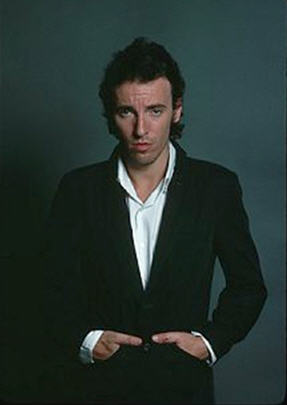
The Boss using his Thumb Protruding from Coat Pocket gesture
Thumb displays can become obvious when a person gives a contradictory verbal message. Take, for example, the lawyer who turns to the jury and in a soft, low voice says, 'In my humble opinion, ladies and gentlemen ...' while displaying his thumbs and tilting back his head to 'look down his nose' at them.
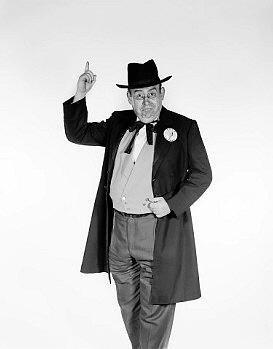
An old school lawyer pretending to be humble
This can make the jury feel that the lawyer is being insincere or pompous. If a lawyer wanted to appear humble, he should approach the jury with his coat open, with open palms and stoop forward to appear smaller.
Thumbs sometimes protrude from the back pockets as if the person is trying to hide their dominant attitude. Women were rarely seen using Thumb Displays until the 1960s when they began to wear pants and take on more authoritative roles in society.

Thumb display revealing confident, authoritative attitude
Arms Folded with Thumbs Pointing Upwards is another common thumb cluster. This is a double signal, showing a defensive or negative attitude (folded arms), plus a superior attitude revealed by the thumbs. The person using this cluster usually gestures with his thumbs when he talks, and rocks on the balls of his feet when standing.
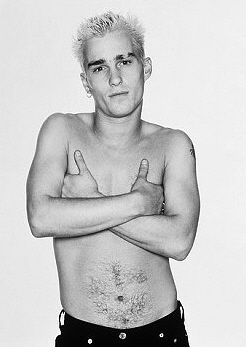
Closing himself off but still feeling superior
Thumbs Up
One of the most ubiquitous of thumb display gestures is the 'thumbs-up'. In most cultures, this hand gesture means, 'Everything's okay', 'I have it under control', or 'I'm powerful'. When a fighter pilot is ready for take-off, he makes this hand gesture to re-assure his fellow service members, signaling he's ready to go for it.

Recep Tayyip Erdogan and Nicolás Maduro displaying confidence
The thumb can also be used as a signal of ridicule or disrespect when it is used to point at another person. For example, a guy who leans across to his friend, points towards his wife with his thumb and says 'She can nag at times', is inviting an argument with her. In this case, the backward pointing thumb is used as a pointer to make fun of her. Consequently, thumb-pointing is an irritant to most women, particularly coming from a man. The Thumb Thrust gesture is not common among women, although they sometimes use the gesture to point at people they don't like.

With Rachel, it can be a delicate balancing act. At the moment it's ... "let's leave, I'm bored". Randomly, at home the mood might be "NO WAY the guys are trashing my living room this weekend watching football, leaving beer bottles and half-eaten food strewn all over!" Seriously though ... no complaints, life is good.
Summary
The thumbs have been used as a sign of power and authority for thousands of years. In Roman times, the thumb held up or down meant life or death to a gladiator. Even without any training, others intuitively decode thumb signals and seem to understand their meaning. You are now in a position not only to decode thumb signs, but to train yourself to use them.



